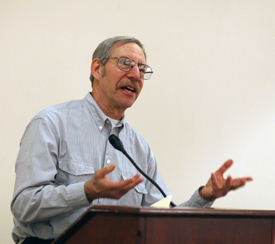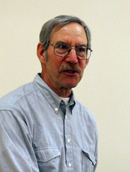Beer and circus!
The aforementioned words are not usually juxtaposed to each other. Nonetheless, Indiana University Professor Emeritus Murray Sperber found it in the most interesting of places – college campuses.
 Dr. Sperber, author of Beer & Circus: How Big-Time College Sports is Crippling Undergraduate Education, delivered a talk in Baxter 101 Thursday delving deeper into his theories about the unique intertwining of college sports, alcohol consumption, the media and college.
Dr. Sperber, author of Beer & Circus: How Big-Time College Sports is Crippling Undergraduate Education, delivered a talk in Baxter 101 Thursday delving deeper into his theories about the unique intertwining of college sports, alcohol consumption, the media and college.
According to Dr. Sperber, there have been three trends that have contributed to this increase in prominence of alcoholic consumption (the "beer") and the lifestyle commonplace in many large state universities (the "circus").
The first is the rise of the research imperative at large universities. Large state institutions like Indiana and Purdue, argues Dr. Sperber, have refocused their efforts on research, many times at the negligence of their undergraduates. In order to be tenured, professors are pushed to publish more and more articles in important journals and books in their field of study. It is research that garners prestige of the institution and having professors spend lots of their time teaching undergraduates is an inefficient use of their time, in context of the large state institution.
The second trend towards beer and circus on college campuses is the rise of ESPN. At the time of the network’s founding in 1979, college football was relegated to Saturday afternoons, as per NCAA regulations. Around the time of the founding of the Big East, conferences began negotiating contracts with network organizations like ESPN. Thus, college football as well as other prominent athletic events like the NCAA Tournament rose in prominence with a voracious viewer ship. This is why NCAA football games can be seen nearly every day of the week during the season. The rise of television viewership of college sporting events saw a congruent rise in gambling. Today, the industry tops out at around $6 billion.
The third trend is the rise in Beer advertising. In the 1980s, according to Dr. Sperber, beer companies began to craft marketing campaigns with characters like Spuds MacKenzie and lowered the price of beer in order to direct their product towards the targeted demographic – college men. The consumption of beer rose, and those same marketing campaigns had an unanticipated side affect, attracting college women in droves to consume beer at rates never seen before.
 In the aftermath of those three trends, Dr. Sperber would argue that two models of college alcohol consumption emerged – high binge and low binge schools. At high binge institutions, there is a great feeling of alienation among the student body. Many students come to high binge schools and "park" themselves in college for four years. Major partying and alcohol consumption begin in earnest on Thursdays instead of Fridays; many of these institutions never have Friday classes.
In the aftermath of those three trends, Dr. Sperber would argue that two models of college alcohol consumption emerged – high binge and low binge schools. At high binge institutions, there is a great feeling of alienation among the student body. Many students come to high binge schools and "park" themselves in college for four years. Major partying and alcohol consumption begin in earnest on Thursdays instead of Fridays; many of these institutions never have Friday classes.
Many graduates of high binge schools articulate their "best college experiences" in terms of social interaction, whether it is reflecting on a sports championship won, major party or Spring Break.
Low binge schools have smaller classes, and libraries in these institutions are characteristically full most nights. Dr. Sperber was quick to note that alcohol consumption is germane on these campuses too; it is just relegated to the weekends. Low binge graduates generally reflect on their "best college experiences" in terms of professors as well as interesting or challenging courses; in other words, the educational aspects of school.
Dr. Sperber ended his talk noting that many university administrators have attempted to move away from an institutional model that seems to promote ‘high binge’ behavior. It is difficult to do so because of the entrenched research centric model of education coupled with the power and eminence broadcast sporting events. That is further complicated by the fact that many of the state institutions most prone to high binge behavior have administrators looking for promotions to other administrative positions, as the average state institution administrator stays at an institution for four years.
Many in the crowd found vindication for why they came to Wabash in Dr. Sperber’s analysis.
"I think what we do here is a lot of hard work," said Tanner Tritch’10, "and all of the students who go to other campuses on weekends can probably testify to a lot of what he is saying is true. At other schools they might not take academics as seriously and they are there for more of the social purposes, which is a lot different than what we have here."
President Patrick White appreciated Dr. Sperber’s analysis of the status of sports and found important information for Wabash to learn.
"Sports are very important at Wabash," he said, "and in his [Dr. Sperber’s] talk he gave us a context of a larger world in which sports connect to the media, to larger universities, and to money. I think we have to find our way in which sports at Wabash remain steeped within and committed to our special traditions."